Address any questions or comments regarding this newsletter to the individual authors listed after each article or to its editors, Nathan Johanning, 618-939-3434, njohann@illinois.edu or Bronwyn Aly 618-695-6060, baly@illinois.edu. The Illinois Fruit and Vegetable News is available on the web at: http://ipm.illinois.edu/ifvn/. To receive or be removed from email notification of new postings of this newsletter, contact Nathan Johanning or Bronwyn Aly at the phone numbers or email addresses above.
In This Issue:
Upcoming Programs (listings for beginning and established growers)
News & Announcements (Follow safe food production practices: COVID-19 facts for farms, markets, and gardens, How does ‘stay at home’ order impact farmers markets?)
Regional Reports (northern, west central Illinois, St. Louis metro east, southwestern Illinois, southern Illinois, Dixon Springs)
Fruit & Vegetable Production & Pest Management (Warm Winter Weather Sets Stage for Corn Flea Beetle Development and Stewarts Wilt, Growing Degree Day for Insect Development, Utility of Sticky Yellow Cards, On-Farm Potato Variety Trial Results)
Upcoming Programs
See the University of Illinois Extension Local Food Systems and Small Farms Team’s website at:
http://web.extension.illinois.edu/smallfarm/ and the calendar of events at http://web.extension.illinois.edu/units/calendar.cfm?UnitID=629.
- Summer Horticulture Field Day. Thursday, June 11, 2020. Edwards Apple Orchard West 8218 Cemetery Rd, Winnebago, IL 61088. Educational program and Farm Tours as a part of the annual summer field day organized by the Illinois State Horticulture Society. For tickets visit www.tickettailor.com/events/ishs. For further information about the program contact Jenna Spychal jenna@jonamacorchard.com or 815-825-2158.
- Pumpkin Field Day. Thursday September 3, 2020 10:00 a.m. SIU Belleville Research Center, 2036 Charles Ln. Belleville, IL 62221. Variety and Pest Management trials and much more! Save the Date! More information to come. Contact Nathan Johanning at njohann@illinois.edu or 618-939-3434.
News & Announcements
Follow safe food production practices: COVID-19 facts for farms, markets, and gardens
The current health issue has disrupted normal daily activities. There are many questions for growers and producers, as well as managers of farmers markets. Trust this researched advice from reliable sources.
“Coronaviruses are a large family of viruses which may cause illness in animals or humans. In humans, several coronaviruses are known to cause respiratory infections ranging from the common cold to more severe diseases such as Middle East Respiratory Syndrome (MERS) and Severe Acute Respiratory Syndrome (SARS). The most recently discovered coronavirus causes coronavirus disease COVID-19.” (World Health Organization)[1]
“The virus is thought to be spread mainly from person to person … who are in close contact with one another (within about six feet) through respiratory droplets produced when an infected person coughs or sneezes.” (Centers for Disease Control and Prevention)[2]
“Currently, there is no evidence to support transmission of COVID-19 by food.” (Food and Drug Administration)[3]
Follow these food handling and food production practices at roadside stands, U-pick farms, farmers markets and community gardens to maintain good agricultural safety practices:
- Wash your hands frequently. Properly wash hands with soap and water for 20 seconds or longer; rinse and dry with single-use paper towels or, if this is not available, use a 60% ethanol or 70% isopropanol hand sanitizer, according to the CDC.
- Clean and Sanitize your work area. “Studies suggest coronaviruses (including preliminary information on the COVID-19 virus) may persist on surfaces for a few hours or up to several days. This may vary under different conditions (e.g. type of surface, temperature or humidity of the environment).” (World Health Organization)[4] Clean surfaces at least daily.
- Use EPA-endorsed products. These products can be used to disinfect or sanitize surfaces that are contaminated with the novel coronavirus. Decide which products are appropriate, based on the EPA label and the Safety Data Sheet for that product. When in doubt, confirm that the labeling of the sanitizer is appropriate for use on food contact surfaces.
(Environmental Protections Agency) - Introduction to Selecting an EPA-Labeled Sanitizer provides guidance on selecting sanitizers and links to an Excel tool to help growers select a sanitizer suitable for their operation. Keep In mind, the PSA Sanitizer tool and the EPA N list were created for different reasons and they project different information. When in doubt, in reference to COVID-19, use the EPA N list. (Cornell University)
- Use the search tool at EPA List N to help determine the sanitizer to use with food products.
- Sick employees should remain home and follow all recommendations by the CDC and the public health department.
- Check out these Illinois Extension COVID-19 resources.
Additional resources for COVID-19 can be found at:
- Produce Safety Alliance: Food Industry Resources for Coronavirus (COVID-19)
- Centers for Disease Control: Coronavirus (COVID-19)
- World Health Organization : Rolling Updates on Coronavirus Disease (COVID-19)
- U.S. Food and Drug Administration: Frequently Asked Questions
Sources:
World Health Organization. 2020. Q&A on coronaviruses (COVID-19).
Centers for Disease Control. 2020. How COVID-19 Spreads.
U.S. Food & Drug Administration. 2020. Food Safety and the Coronavirus Disease 2019 (COVID-19).
World Health Organization. 2020. Q&A on coronavirus (COVID-19).
Laurie George (618-548-1446; ljgeorge@illinois.edu) and Zachary Grant (708-449-4320; zgrant2@illinois.edu) and James Theuri (815-933-8337; jtheu50@illinois.edu)
How does ‘stay at home’ order impact farmers markets?
With winter farmers markets in full swing, the March 20 executive order by Gov. Pritzker requiring individuals to stay at home has market managers wondering if they can stay open. The order considers agriculture an essential business, paving the way for growers and farmers markets to remain open at the time of this writing.
“All first responders, emergency management personnel, law enforcement personnel, health care workers and others working to support essential businesses and essential government functions, like grocery stores and pharmacies are exempt from this stay at home order,” the order indicates. Agricultural operations currently allowed include “food and beverage manufacturing, production, processing, and cultivation, including farming,” and includes “cultivation, marketing, production, and distribution of animals and good for consumption,” the order further indicates.
Travel to and from food production areas and marketplaces may occur. Congregation of employees and customers must be done in accordance with social distancing requirement of six feet, and market vendors and managers may need to revamp current food safety rules and regulations to comply fully.
What vendors should consider
- As in all cases, employees should be healthy if they are at work.
- Clean and sanitize your booth and equipment on a regular basis throughout the market day. Cleaning means using soap and water and sanitizing means using a product labeled for sanitizing which can be used on food contact surfaces. Guidelines from the Environmental Protection Agency are available. When in doubt, confirm that the labeling of the sanitizer is appropriate for use on food contact surfaces.
- Follow any guidelines from the Illinois Department of Public Health about product sampling. Although no final decision on product sampling has been made at the time of this writing, markets may wish to discontinue the practice.
- Have a hand washing station at your booth, and instruct all workers to use it on a regular basis
- Minimize the number of times the produce is touched, from on-farm harvest through market sales.
- Designate a worker that is only responsible for taking money and require them to wear gloves for all transactions.
- Have all workers use disposable gloves when working with fresh produce and instruct them on how often to change gloves throughout the day.
- Do not allow the customer to pick up produce to test for ripeness or smell before buying.
- Growers may want to pre-bag produce prior to opening and explain to customers that this is for their own safety.
- Remind customers to wash the produce when they get home.
What managers should consider
- Practice social distancing. Extend the distances between the market booths and avoid shaking hands or any other physical contact.
- Follow any guidelines from the Illinois Department of Public Health about product sampling as previously discussed.
- Have hand washing stations throughout the market for the public to use and post signs reminding patrons to use soap and water for 20 seconds before rinsing and drying with a single-use paper towel.
- Limit or restrict animal access into the market.
- Temporarily eliminate seating areas within the marketplace to promote social distancing.
- Initiate customer educational programs through your market website, social media sites, and newsletters and advise people not to attend the market if they are ill.
- Have a sign prominently displayed at the market entrance or at each vendor booth promoting social distancing of at least six feet in public spaces.
Laurie George (618-548-1446; ljgeorge@illinois.edu) and Zachary Grant (708-449-4320; zgrant2@illinois.edu) and James Theuri (815-933-8337; jtheu50@illinois.edu)
Regional Reports
From northern Illinois…Growers have finished pruning fruit trees in the last week and are shifting over into making plans for the upcoming season. This has meant conversations on launching new social media efforts, putting up a new high tunnel, determining new crops to look to grow, doing research on potential new markets in our area, and reaching out to established customers. I have seen a number of growers utilize their social media the last week to reach out to their customers to share what they are doing at the farm and overall check in with their community of supporters. As many people are working remotely, they are very active on social media channels and this is a good time to reconnect to share your farming journey and story.
We had a great turn out at our Stateline Fruit and Vegetable Growers Conference in Rockford at the end of February. Our keynote was Dr. Jed Colquhoun from the University of Wisconsin who delivered an overview on weed management in small fruits and tree fruits. In addition, growers were able to hear about soil health in fruit/vegetable production, marketing and branding their operation, updates from Dr. Babadoost, and a special session on hemp production for specialty growers.
Grant McCarty (815-235-4125; gmccarty@illinois.edu)
From west central Illinois (Quincy)…What a crazy time we’re living in, trying to guess what the future holds and wondering what all this will mean to us, both personally as well as our business. We’re continuing to move forward in the hopes that life will get back to “normal” relatively soon, as I’m sure every other producer is.
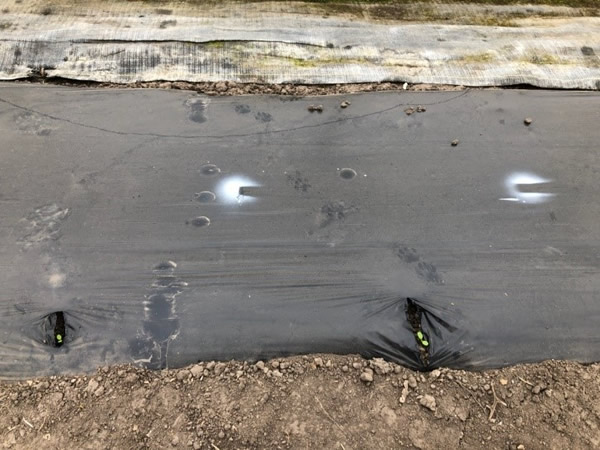
During the first week of March, some of the better drained soils were dry enough that area farmers could begin anhydrous applications and do some tillage work. We managed to get a few beds of plastic laid, where our onions, cucumbers and cole crops will be planted. I opened the ground up on Saturday the 7th, and by Sunday, it worked exceptionally well. Lots of wind and sun can work wonders. It started raining the next week, and soils are very wet now.
Tomato transplants were started in many greenhouses in mid-February, although I’ve talked to a few growers who had already transplanted by March 1st. Of course, those high tunnels are supplemented with heat (wood or LP). A number of other crops and flower transplants have greenhouses full or close to it. The cloudy weather of late sure isn’t accelerating growth and is causing the need for supplemental heat to continue.
I’ve been removing rows of spinach in the tunnels to get ready for planting of tomato on April 1st. I cut off the spinach at ground level, fertilize, deep spade then till. After laying two drip lines, the rows are covered with black plastic. I measure and mark 18” with a spray to determine where tomatoes should be planted. In the center of the 18” mark, but on the outside edge, I’ve been cutting a slit and planting head lettuce seeds. We’ll sell those during strawberry season.
Speaking of spinach, we sold more bags of spinach on March 21 as we did the entire week prior to that. I came to the realization that the next day was the day when the stay at home order was to begin, and people were getting ready to follow that directive. Sales of spinach have been pretty regular since last fall. Normally I have to quit sometime during December and resume again late January. But this year, probably due to the warmer temperatures, we were able to sell all winter, with no interruption.
We removed row covers off our plasticulture strawberries March 21, probably a week or so late. The plants look great, considering the -10 temperature we had earlier, with a little ice covering the covers. We saw just a few plants with vole
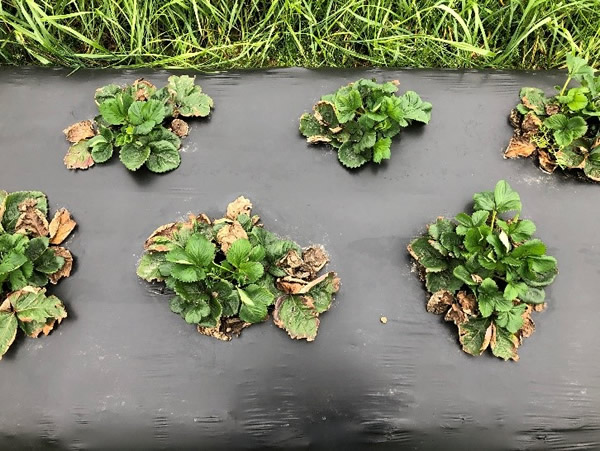
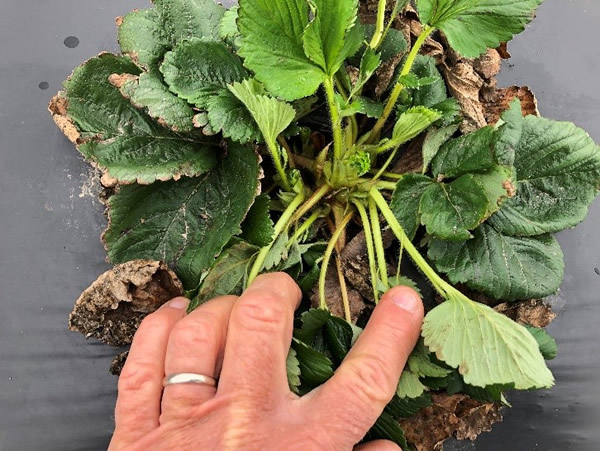
Plasticulture strawberry development and branch crowns. All Photos: M. Roegge
damage where they were eaten to the ground. I elected to discontinue baiting for voles this year due to the number of holes torn through the covers by animals (I’m pretty sure raccoons) digging after the bait. They could smell the grain based bait and were digging it up and consuming it. I’d spend hours each year repairing the covers. We will be mowing off our asparagus this week (hopefully) or next, depending upon the weather. We’ve always mowed off around April 1st, with the first picking around April 15. After mowing I’ll use a pre emerge herbicide tank mixed with glyphosate (to help control perennials) to control weeds.
Mike Roegge (217-223-8380; roeggem@illinois.edu)

Elderberry 'Marge' just past budbreak on March 24, 2020 in the St Louis Metro East. Photo credit: E. Wahle
From the St. Louis Metro east… Even without looking at the calendar, its obvious spring is here. With the first warmup, the familiar sound of lawnmowers will be in the air. The entire St Louis Metro East continues to be wet from continued higher than average rainfall. Temperatures took another dip this past weekend to just above freezing, but are expected to work their way back up into the low 70’s by the end of the week, with more rain along the way. That should really move things along in terms of plant development, so growers should expect critical pest control stages to develop quickly and be prepared to make those critical early-season pesticide applications. Soil temperatures at the SIU Belleville Agricultural Research Station are 43.4°F under bare soil at 2”, and 29.1°F under bare ground at 4”. Strawberries have been uncovered, with irrigation systems for frost protection installed, as well as initiation of fertility programs. A bloom here and there can be found in Sweet Charlie blocks, but otherwise flower clusters are still fairly tight on all cultivars. Blackberries are past bud break and leaves are just beginning to expand. With the exception of Bounty, which has a few open flowers, peaches are at bud swell to pink. Most apple are still at silver tip, but a few like Braeburn and Liberty are at ¼” green. Other fruit like apricot is in full bloom. Cherries are showing signs of bud swell, but still not quite to popcorn stage. Elderberries have broken bud and leaves are just beginning to expand. No signs of asparagus yet, but that is to be expected. Garlic planted last fall came through the winter in good shape so far. High tunnel tomatoes should be going in soon. One grower reported successfully getting an onion planting in already. Pruning is ongoing in peaches and grapes. Planting of nursery stock (apple, peaches, Christmas tree, etc.) is on hold for right now until soils dry down.
Elizabeth Wahle (618-344-4230; wahle@illinois.edu)
From southwestern Illinois (Waterloo)... It has been fairly wet lately in southern Illinois. We have had multiple storm systems bringing showers to the area including fairly steady rain on Tuesday (3/24) and even had some large snowflakes falling this past Sunday (3/22) although they did not amount to anything. Back before the wet period we are in now, at the end of February the soil actually dried out enough for plowing and some early planted crops like lettuce, spinach and peas for a few days. This is actually the driest I can remember it getting in the late-winter for a few years. Traditionally, I always could count on a time in late-winter that the soil would dry out and often was a good time to frost seed clovers and fertilize wheat and do some early tillage. However, the last few years this opportunity was minimal at best with some very wet winters. Our temperatures have been mainly in the 40-50s for highs and seemingly endless cloudy days. The forecast shows that we will warm some into the 50s & 60s, maybe some 70s and hopefully get a few days of dry weather and some sunshine.
Out in the field, some earliest of cool season crops have been snuck out in the field, but most are still waiting for a little better conditions. Cover crops have started to green-up. Cereal Rye is now about 4-6” tall. I have not seen any signs of asparagus emergence as of yet. Now is the time, if not before to think about spraying any burndown herbicide applications on asparagus. If there is no sign of any spear emergence, I often use Roundup and sometimes add 2,4-D to control resistant weeds (ie. marestail), perennials, or trees. Also, I would add some form of a residual herbicide as well to suppress new weed germination over the next month. I like using this combination as this cleans up everything present and will hold back weeds until later in the harvest season. I like using the Roundup early with no green tissue of the spears which greatly lessens the potential for damage and then using a Gramoxone later after harvest, knowing it will have less chance to cause injury should there be some spears present after mowing. If you do get caught with any emergence before you spray, one thought is to find a day to spray right after a morning frost/freeze. The cold will kill back any stray spears that could otherwise intercept a herbicide. Remember though that asparagus can grow quickly so don’t wait long after that cold event. Consult the Midwest Vegetable Production Guide for more details on herbicide recommendations for asparagus or any pest in other crops.
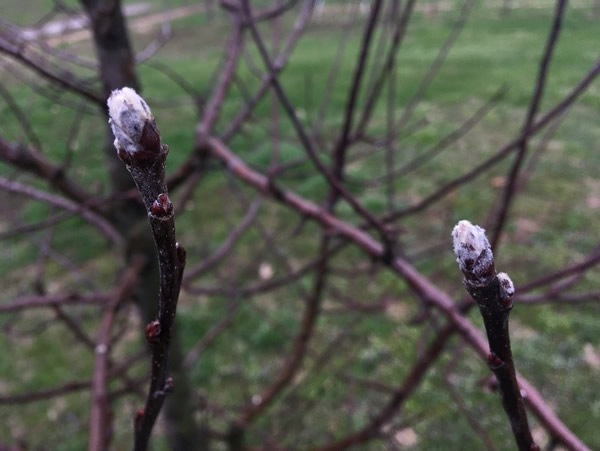
Out in fruit crops, we are starting to see some activity. Apricots are in full bloom, peaches are at pink, tart cherries have swollen flower buds and are just showing some green, and apples are at silver tip. Early blueberries have swollen buds with green showing. Brambles and grapes have not shown much activity yet. So far the forecast doesn’t show temperatures below about 40° so hopefully we can escape any injury as bloom continues to progress. Now is a great time to get some fresh mulch out on blueberries. Blueberries are very shallow rooted and more so than other crops benefit from regular mulching. Commonly sawdust, woodchips, chopped leaves, pine straw or wheat or other small grain straw. For any spray recommendations as our fruit crops start the season check out the Midwest Fruit Pest Management Guide.
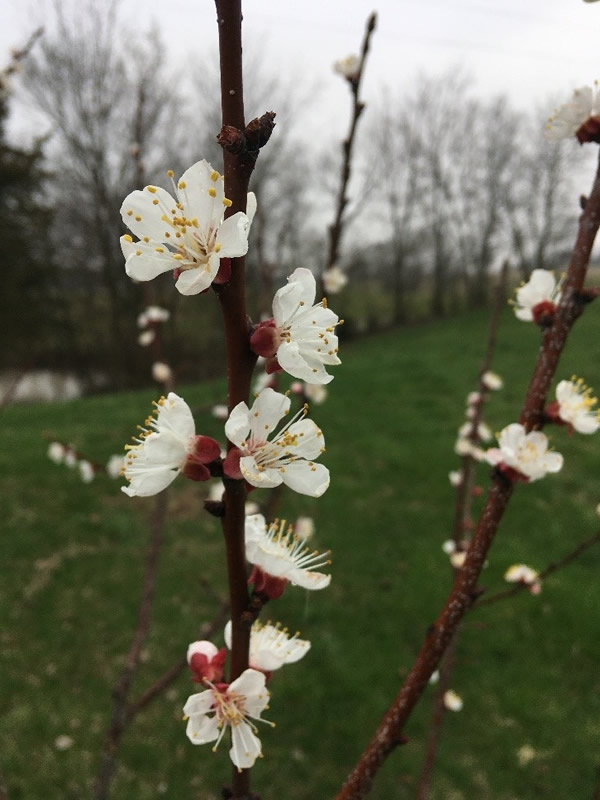
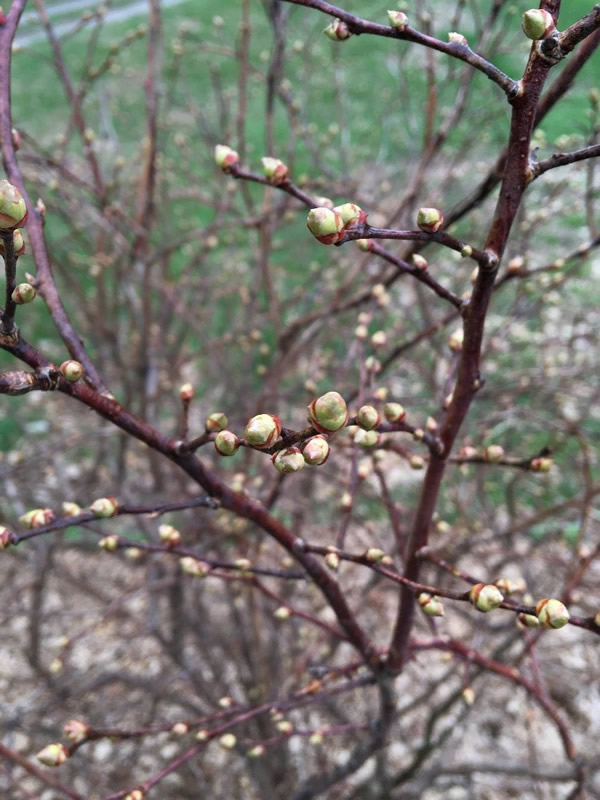
Current growth progress on Apples ‘Goldrush’ (top), Apricots ‘Wilson Delicious’ (bottom left), and Blueberries ‘Duke’ (bottom right). Photos: N. Johanning
Hopefully everyone is staying healthy and is making the most of the coronavirus limitations we have. Certainly, it has me thinking more about our food system and marketing avenues. Take a look at some of the resources we have in this issue about how the coronavirus might impact how we market and handle food safety. Know that we will try our best to provide updated information as time goes on and things progress. Stay well!
Nathan Johanning (618-939-3434; njohann@illinois.edu)
From southern Illinois (Murphysboro)… Over the past month we have made progress on filling and tilling the beds in the high tunnel. We sowed an oat cover crop in two of the beds, and it is coming up quite nicely. We have started more seedlings including tomatoes, squash, and okra. Plans are being laid out to put in a demonstration herb garden here at the Jackson county office. The garden will serve to educate community members and 4-Hers about various herbs and their uses. Currently, we have thyme, fennel, parsley, cilantro, dill, and basil growing.
Through the rain and dreariness, it is clear that spring has sprung. The bush cherries are blooming, and the blueberry bush is at bud swell. I look forward to getting out into the field in the coming months.
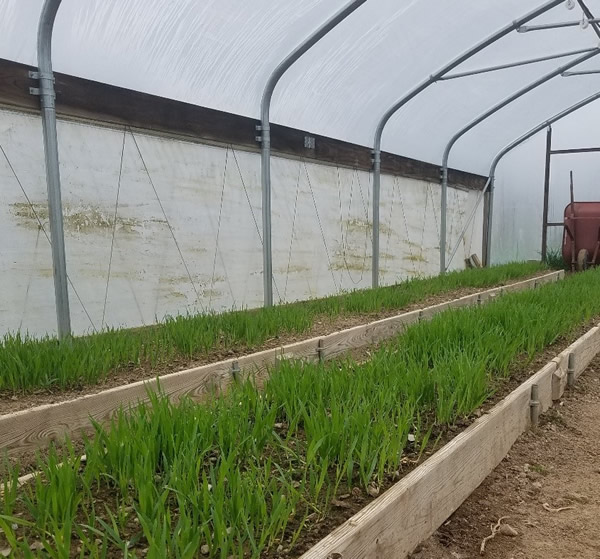
Photos by K. Bell. Oats in the Jackson County high tunnel
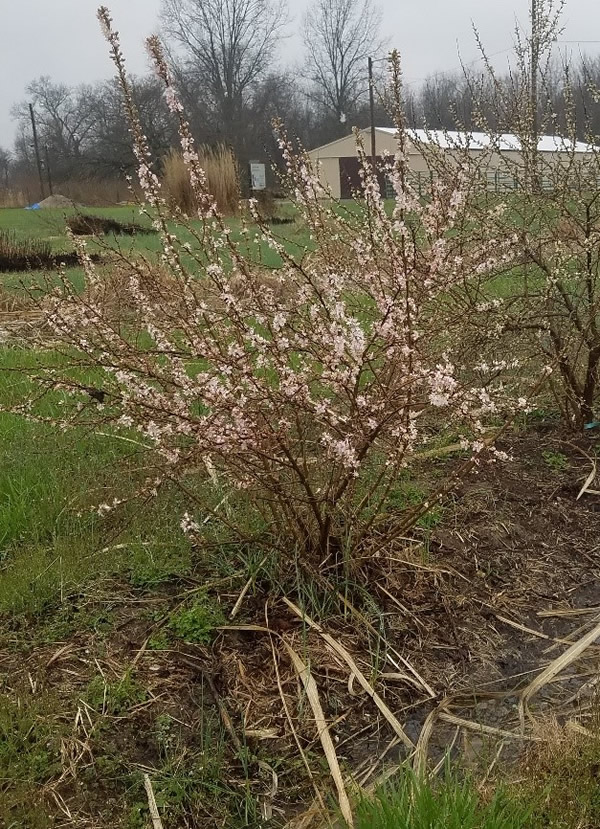
Bush Cherry in bloom at the Jackson County office
Katie Bell (618-687-1727; klbell@illinois.edu)
From Dixon Springs Ag Center…Just like the rest of southern Illinois, we have seen many cloudy, rainy days this past month. As I am writing this update, the sun is finally shining and it really feels like spring is in the air. The picture of
the apple tree is from my yard. I don’t know the variety as it was planted years before by the previous owner. I do know that it is a summer apple and it is has several flower buds that range from bud swell to tight cluster to pink.
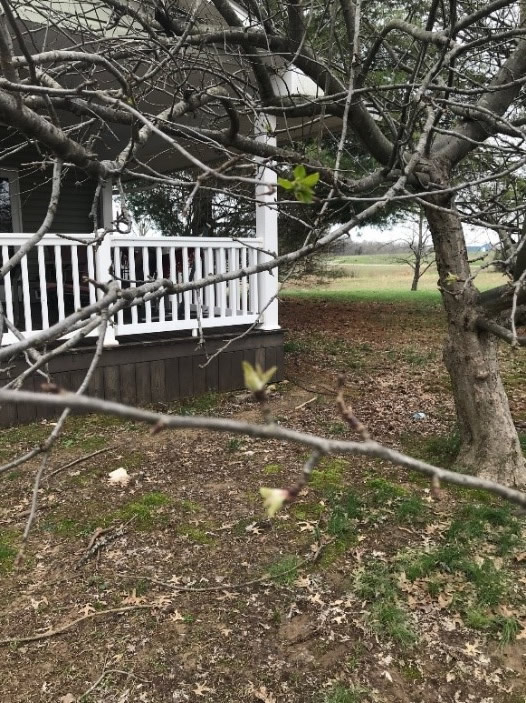
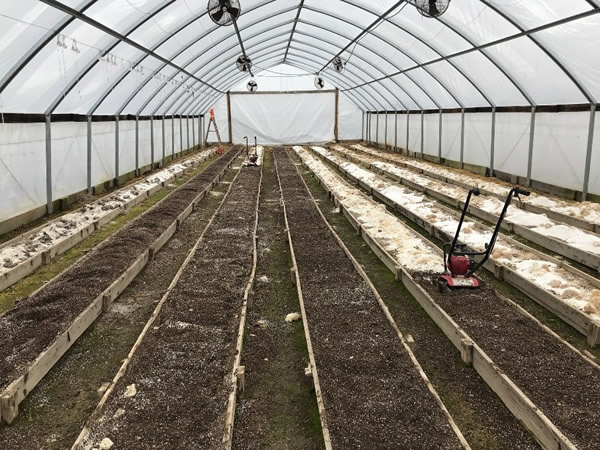
Summer apple tree in Pope County and bed preparation in high tunnel at DSAC. Photos by B. Aly.
Bed preparation is continuing, with the incorporation of last season’s perlite that was used as media in our hydroponic production tunnel. Utilizing these narrow tillers, we are able to slowly work down each bed, letting the tiller work as deep as possible to break up compacted areas and incorporate the perlite, giving the appearance of potting soil. These beds will be wetted down before tarping and steaming. We have found that the steaming process is more effective and can take less time when the beds have been worked and moistened. The benefits of steaming include improved weed suppression and a reduction in disease pressure. During the steaming process, we are able to raise the soil temperature to around 140 F and hold it at the temperature for about an hour. At this temperature, many weed seeds and disease pathogens will be killed, although a few of the weed species with a harder seed coat can survive. While this process does not guarantee a complete sanitation of the soil, it does help to reduce potential issues that could reoccurr, especially in a high tunnel situation when crop rotation options are limited.
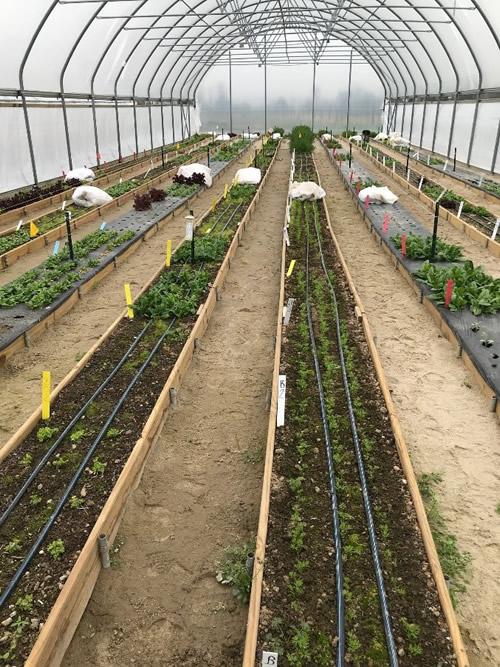
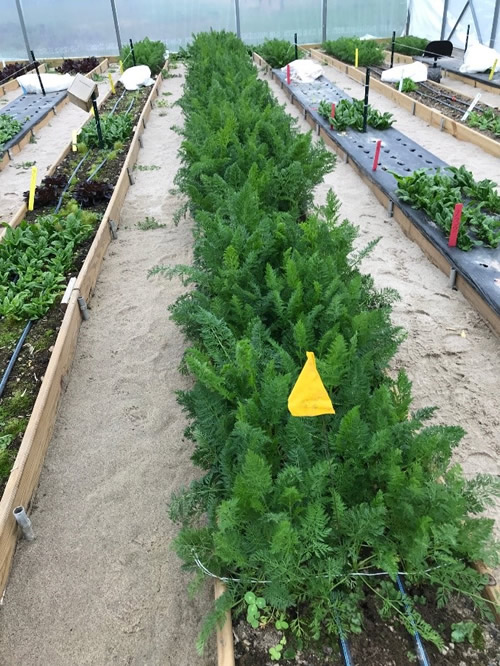
Winter vegetable production plots in high tunnel at DSAC. Carrot plantings are in various stages of development, kale and lettuce plots have been terminated or harvest completed, and spinach plots vary in their production, from almost spent to still going strong. Photos by B. Aly.
Some of the winter vegetable production plots are still being harvested while others have been terminated or their harvest was complete for the season. Kale plots from all three planting dates (Sept., Oct. Nov.) have been terminated as of this week as the plants had started to bolt. Carrot plots from Aug, Sept, and Oct planting dates have been harvested. The picture on the right shows the growth of the Nov planted carrots as compared to the Feb plants carrots that are in the closest plot shown in the picture on the left. The Sept planted spinach is basically shot while the Nov spinach is still coming on strong. All of the head lettuce plots have been harvested but the Nov planted cut and come again lettuce mix is still being harvested. We have not had to use the row covers much at all through this winter season, especially not in the past month. It will be interesting to see the yield results between the different treatments once all of the harvest data is collected.
Bronwyn Aly (618-382-2662; baly@illinois.edu)
Fruit & Vegetable Production & Pest Management
Warm Winter Weather Sets the Stage for Corn Flea Beetles and Stewart's Wilt
A little different from the winter we experienced in 2018-2019, average winter temperatures in Illinois were a bit higher in much of the state this winter. (Figure 1). Warmer temperatures during the months of December, January and February favor increased survivability of the corn flea beetle and subsequently, the early season prevalence of Stewart’s Wilt.
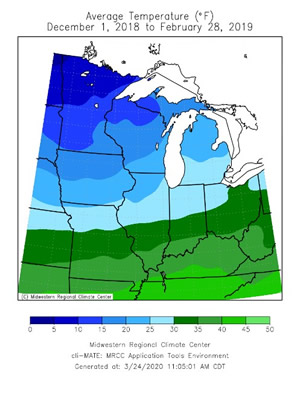
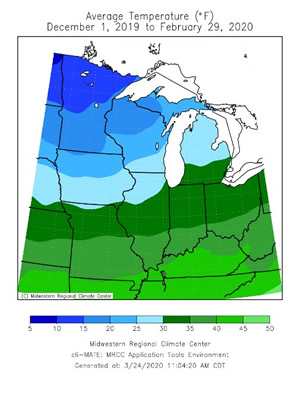
Figure 1. Average winter temperatures of 2018-2019 and 2019-2020.
Corn flea beetles are the primary vector of Stewart’s Wilt. Erwinia stewartii, the bacterium that causes Stewart’s Wilt, survives the winter in the gut of the corn flea beetle and the survival of the corn flea beetle is dependent on winter temperatures. Warmer winters result in greater survivorship of corn flea beetles, thus increasing the potential for Stewart’s Wilt, while colder temperatures adversely affect it. Using the average temperatures of December, January, and February, the potential for Stewart’s Wilt can be predicted (Table 1).
Table 1. Projected risk of Stewart’s Wilt based on the average temperatures of December, January, and February.
Average temperature of December, January, & February |
Probability of early season wilt |
Probability of late season blight |
<27° F |
Absent |
Trace, at most |
27-30° F |
Light |
Light to Moderate |
30-33° F |
Moderate |
Moderate to Severe |
>33° F |
Severe |
Severe |
Corn flea beetles become active in the spring when temperatures rise above 65°F, and they feed on and transmit Stewart’s Wilt bacteria to seedling corn plants. The bacterium can spread systemically throughout the plant. Although most commercial field corn hybrids are resistant to Stewart’s Wilt, the disease is still a concern for susceptible seed corn inbreds and many sweet corn hybrids.
There are two phases of Stewart’s Wilt: the seedling wilt phase and the leaf blight phase. The seedling wilt stage occurs when seedlings become infected at or before the V5 stage. The vascular system becomes plugged with bacteria, causing the seedling to wilt, become stunted, and die. Infections of older corn plants usually result in the development of the leaf blight phase of Stewart’s Wilt. This phase is characterized by long, yellow to chlorotic streaks with wavy margins along the leaves. When the late infection phase or “leaf blight phase” of Stewart’s Wilt occurs after tasseling, it is generally not a concern in sweet corn because ears are harvested before damage occurs.
Based on the recent winter temperatures from the Midwest Regional Climate Center, estimates of early season Stewart’s Wilt are shown in Table 2. Remember, however, that these are only predictions; numbers of surviving corn flea beetles are not known.
Table 2. Early season Stewart’s Wilt predictions, 2020
Location |
Average temperature December 2019-February 2020 |
Early Season Wilt |
Freeport |
27° F |
Light |
DeKalb |
27° F |
Light |
Monmouth |
30° F |
Light/Moderate |
Peoria |
32° F |
Moderate |
Champaign |
32° F |
Moderate |
Springfield |
33° F |
Moderate/Severe |
Newton |
36° F |
Severe |
Belleville |
38° F |
Severe |
Mt. Vernon |
37° F |
Severe |
Carbondale |
38° F |
Severe |
Dixon Springs |
41° F |
Severe |
Kelly Estes, State Survey Coordinator, Illinois Cooperative Agricultural Pest Survey (217-333-1005; kcook8@illinois.edu)
Modified Growing Degree Days for Insect Development (Base 50⁰ F, January 1 through March 23)
Station Location |
Actual Total |
Historical Average |
One- Week Projection |
Two-Week Projection |
Freeport |
10 |
21 |
24 |
41 |
St. Charles |
16 |
25 |
31 |
48 |
DeKalb |
12 |
26 |
29 |
49 |
Stelle |
24 |
38 |
43 |
68 |
Peoria |
37 |
49 |
59 |
88 |
Monmouth |
30 |
41 |
50 |
76 |
Champaign |
44 |
53 |
64 |
92 |
Springfield |
52 |
62 |
75 |
107 |
Perry |
57 |
71 |
82 |
116 |
Brownstown |
70 |
89 |
97 |
135 |
Olney |
82 |
86 |
108 |
144 |
Belleville |
110 |
106 |
139 |
180 |
Rend Lake |
102 |
114 |
134 |
178 |
Carbondale |
133 |
118 |
165 |
208 |
Dixon Springs |
139 |
137 |
174 |
221 |
Insect development is temperature dependent. We can use degree days to help predict insect emergence and activity. Degree day accumulations calculated using the Pest Degree-Day Calculator
Kelly Estes, State Survey Coordinator, Illinois Cooperative Agricultural Pest Survey (217-333-1005; kcook8@illinois.edu)
The Utility of Yellow Sticky Cards
Reprinted by permission from the Purdue Vegetable Crops Hotline
Date: March 16, 2020 - Included in Vegetable Crops Hotline Issue: 669
By: Laura Ingwell
While not a new technology, I thought it timely to talk about the use of yellow sticky cards as a monitoring tool. These cards will not manage insect pests in your crops, but can be a very valuable monitoring tool in high tunnels and greenhouses. Many of the insect pests that migrate into our crops move on wind currents (aphids and mites for example) or the people working in these spaces. Strategically placing sticky cards around the borders of a planting, where they can intercept wind currents, or along high traffic areas, is a great strategy for monitoring early signs of infestations.
Considerations:
- The industry has come to the consensus that yellow sticky cards are the best tool. There is no need to invest in cards with other colors.
- Some cards also contain pheromones, an added chemical to attract a particular pest. For general monitoring this is not necessary. For targeting some specific pests, they can increase the catch (apple maggot fruit fly for example).
- Consider the pest you are monitoring for in terms of placement. Most pests are detected best with a vertical placement of the card, at canopy height. If you are targeting fungus gnats, which emerge from the growing media, place them horizontally over the media.
- Look at the cards on a weekly basis, at least. The more often you check them, the more time you have to react to what you are seeing.
- Start the season with fresh cards and replace them often.
Identifying the critters that get stuck to sticky cards can be challenging. If you are ever in doubt, send the card or pictures to the Purdue Plant and Pest Diagnostic Laboratory.
To reiterate, yellow sticky cards are not a management tool, but rather a very handy monitoring tool. With frequent checking, you can detect pest infestations early, prior to observable populations or symptoms on the host plant. This can aid you in management decisions and provide time to implement biological control, which can be more effective when pest populations are low.
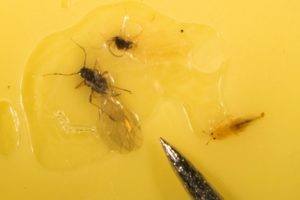
Figure 1. Winged aphids and thrips on a yellow sticky card. Photo by John Obermeyer.
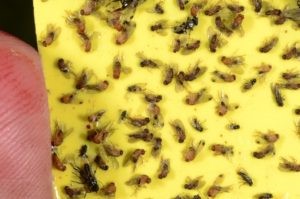
Figure 2. Spotted wing drosophila on a yellow sticky card. Photo by John Obermeyer.
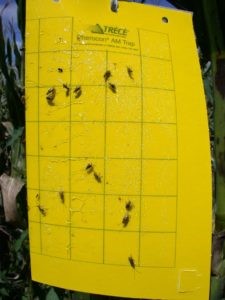
Figure 3. Corn rootworm adults on yellow sticky card. Photo by John Obermeyer.
On-Farm Potato Variety Trial Results
As it is potato planting season, I wanted to take a moment and share some results of a potato variety trial we did back in 2018.
An on-farm potato variety was conducted in southern Illinois in Fults, Illinois during the 2018 growing season. The objective of this trial was to compare the yield and quality of a wide range of colors of potatoes.
Ten varieties of potatoes were planted on April 12, 2018 in a randomized complete block design with 3 replications. Plants were spaced 1 foot apart in 38 inch rows. Plots were one row wide and 8 ft long (8 plants). A soil test indicated that no additional phosphorus (P) or potassium (K) was needed. 100 lb/A nitrogen (N) was applied at the time of planting in the form of urea. An additional 50 lb/A N, in the form of ammonium nitrate, was side dressed at the time of hilling. Weeds were controlled by cultivation, hand weeding and an application of Arrow® 2EC (6 fl oz/A with crop oil concentrate (1% v/v) on June 12, 2018. Harvest data was collected on July 13, 2018 including plant stand, tuber number and weight sorted as marketable or cull, and notes on skin and flesh color.
The marketable harvest data and notes are presented in Table 1 below. Pictures of each variety are also included below the table.
Table 1. Yield Data from the 2018 Potato Variety Trial in Southern Illinois.
Cultivar1 |
Skin Color |
Flesh Color |
Total |
Tuber Size |
|
|
|
Weight |
Number |
(oz) |
|
Kennebec |
White |
White |
1.5 |
5.9 |
4.1 |
Colorado Rose |
Bright Red |
White |
1.3 |
6.8 |
3.1 |
Red Gold |
Reddish Tan |
Yellow |
1.0 |
5.2 |
3.2 |
Purple Viking |
Purple w/ pink |
White |
1.0 |
4.2 |
3.7 |
Mountain Rose |
Bright Red |
White w/ red |
0.9 |
7.4 |
2.0 |
Purple Majesty |
Purple |
Purple |
0.9 |
8.9 |
1.6 |
Yukon Gold |
Yellow |
Yellow |
0.8 |
3.9 |
3.1 |
Desiree |
Reddish Tan |
Yellow |
0.6 |
5.0 |
2.1 |
All Blue |
Purple |
Purple |
0.6 |
6.3 |
1.6 |
Maris Piper |
White |
White |
0.5 |
4.0 |
2.0 |
1 Listed in descending order based on total marketable yield: weight. Seed source: Potato Garden (PG) 12101 2135 Rd, Austin, CO 81410 https://www.potatogarden.com/. |
|||||
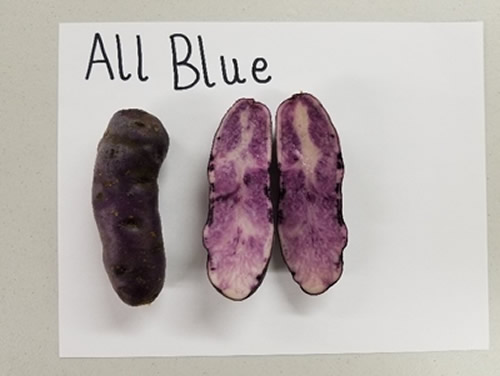
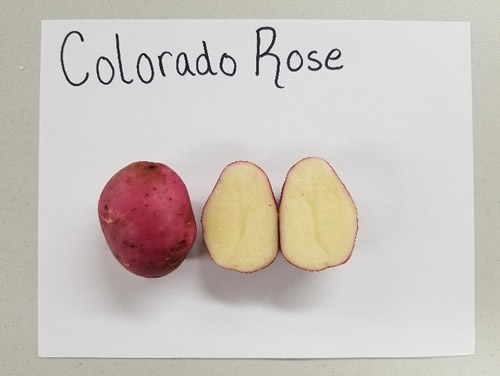
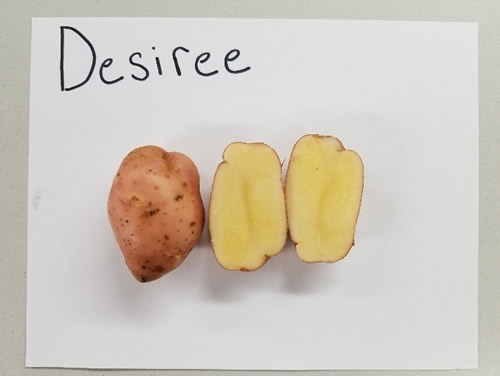
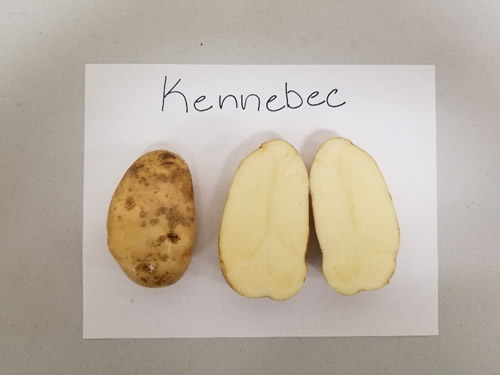
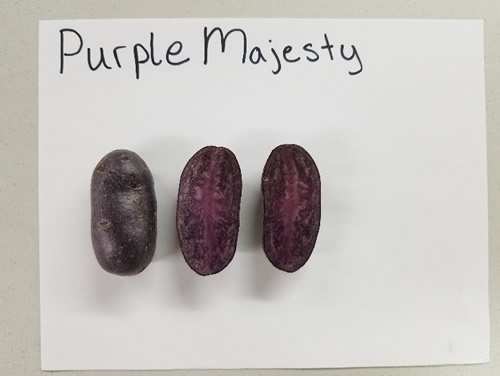
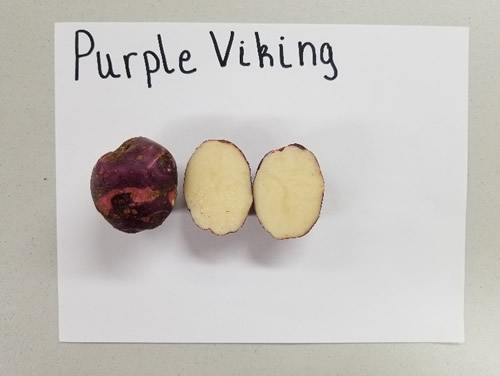
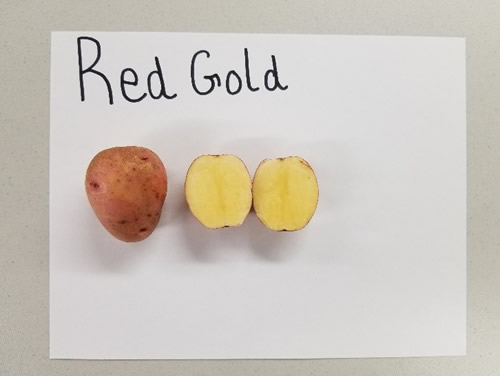
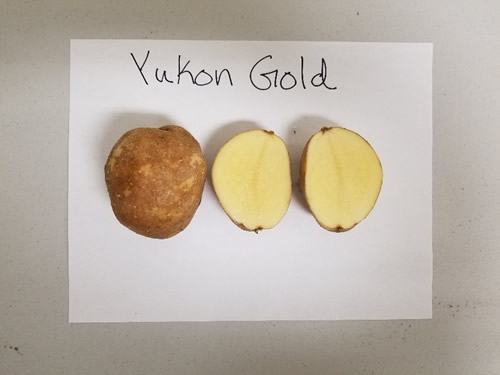
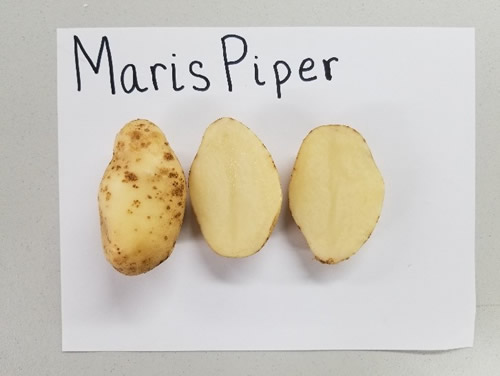
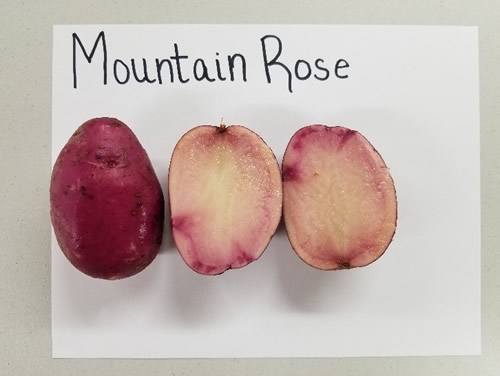
Nathan Johanning (618-939-3434; njohann@illinois.edu)
Less Seriously
With all of the social media memes circulating regarding the COVID-19 situation, I was starting to feel overwhelmed. But then I saw this one and thought of our IFVN subscribers and how this statement is so true anytime, not just in times of a pandemic. We may all have our own personal story related to the mishandling of the below miracle vegetable, some of which we wouldn’t want to share. But remember we are lifetime learners, let’s just hope that if you did experience this lesson that you learned the first time around. Taken from a shared Facebook post.
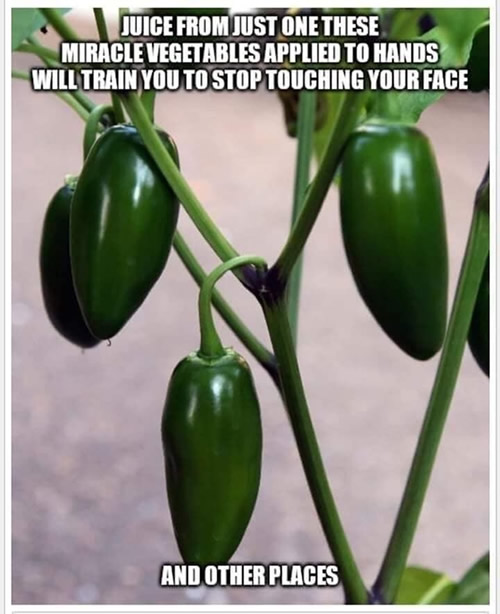
University of Illinois Extension Specialists in Fruit and Vegetable Production & Pest Management
Extension Educators – Local Food Systems and Small Farms |
||
Bronwyn Aly, Gallatin, Hamilton, Hardin, Pope, Saline, and White counties |
618-382-2662 |
|
Katie Bell, Franklin, Jackson, Perry, Randolph, & Williamson counties |
618-687-1727 |
|
Sarah Farley, Lake & McHenry counties |
847-223-8627 |
|
Nick Frillman, Woodford, Livingston, & McLean counties |
309-663-8306 |
|
Laurie George, Bond, Clinton, Jefferson, Marion, & Washington counties |
618-548-1446 |
|
Zachary Grant, Cook County | 708-679-6889 | |
Doug Gucker, DeWitt, Macon, and Piatt counties |
217-877-6042 |
|
Erin Harper, Champaign, Ford, Iroquois, and Vermillion counties |
217-333-7672 |
|
Grace Margherio, Jackie Joyner-Kersee Center, St. Clair County |
217-244-3547 |
|
Grant McCarty, Jo Daviess, Stephenson, and Winnebago counties |
815-235-4125 |
|
Katie Parker, Adams, Brown, Hancock, Pike and Schuyler counties |
217-223-8380 |
|
Kathryn Pereira, Cook County |
773-233-2900 |
|
James Theuri, Grundy, Kankakee, and Will counties |
815-933-8337 |
|
Extension Educators – Horticulture |
||
Chris Enroth, Henderson, Knox, McDonough, and Warren counties |
309-837-3939 |
|
Richard Hentschel, DuPage, Kane, and Kendall counties |
630-584-6166 |
|
Andrew Holsinger, Christian, Jersey, Macoupin, & Montgomery counties |
217-532-3941 |
|
Extension Educators - Commercial Agriculture |
||
Elizabeth Wahle, Fruit & Vegetable Production |
618-344-4230 |
|
Nathan Johanning, Madison, Monroe & St. Clair counties |
618-939-3434 |
|
Campus-based Extension Specialists |
||
Kacie Athey, Entomology |
217-244-9916 |
|
Mohammad Babadoost, Plant Pathology |
217-333-1523 |
|